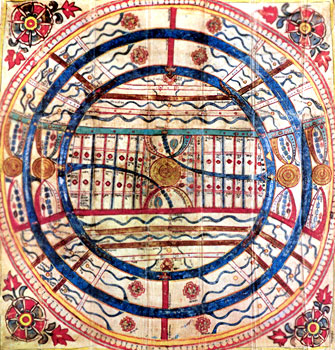 The practice of the Tantric Mandala involves a meditative projection of both the metacosmic godhead and the protocosmic self into its current. Practice of Tantric Mandala is an ancient application and still found in many culture. The image of a Mandala is a powerful healing image as it unites within the viewer the opposite forces of darkness and light. A Mandala is naturally used which has no right or wrong way. One can begin by looking and observing whatever form it takes and feel the energy flow between the Mandala and the heart of the practitioner. The symmetrical geometric shapes draw the attention of the eyes towards their center.
The practice of the Tantric Mandala involves a meditative projection of both the metacosmic godhead and the protocosmic self into its current. Practice of Tantric Mandala is an ancient application and still found in many culture. The image of a Mandala is a powerful healing image as it unites within the viewer the opposite forces of darkness and light. A Mandala is naturally used which has no right or wrong way. One can begin by looking and observing whatever form it takes and feel the energy flow between the Mandala and the heart of the practitioner. The symmetrical geometric shapes draw the attention of the eyes towards their center.
Mandala is mysterious in nature. It is used during meditation as an object for focusing attention. In order to create a Mandala one has to see within oneself clearly. The clearer inner vision, the accurate and powerful is the Mandala. Mandala lives within a circle as the circle is considered as a primal form. Circular aura is an essential factor of Mandala.
A powerful can be created only if there is inner clarity and the ability to replicate the inner vision. A Mandala is an inner cosmic picture which is reproduced for all to perceive it. The Mandala depends on one`s level of consciousness. The more one is evolved, the more universal will be the Mandala that is created. A universal Mandala is created through a mind in tune with cosmic consciousness. It is relevant to all mankind.
In Tantrism Mandalas are pictorial representations of divine forces. This covers an infinite array of forms, colours and depictions. The structure is elaborately detailed and designed to evoke a parallel response within one`s consciousness. Mandala is the energy grid that represents the constant flow of divine, human and animal impulses in the universe. It is tri dimensional as it locates the supreme deity, the source of that energy and ground of the grid itself. All other beings will be situated at lower levels of energy radiating downward and outward from the centre point.
The energy levels of the Tantric universe are represented as a set of concentric circles or chakras. The Mandala is the ideal conceptual tool for plotting the multi-levelled and polyvalent interrelationships. The Tantric Mandala stays as a template through which humans may interact with the divine thereby experiencing reality from a superhuman viewpoint. One`s self-projection into the Mandala and returning slowly to the center is a return to the source of one`s being. All Tantric practices of the Mandala are aimed at transacting with and identifying with that deity. In this practice, movement toward the center involves harmonizing one`s own consciousness level with that of the deities of the circle in which one finds oneself.
Therefore the basic structure and dynamics of the Mandala remain constant despite the variations in the media that flow through it.









